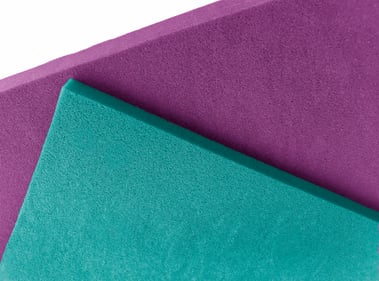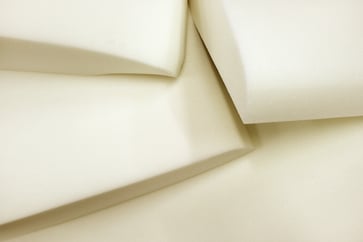Biodegradable polyurethane foam allows you to make products that are environmentally friendly with...
Boost Your Market Share While Controlling Bacteria Growth

Whether a foam is made of a proprietary or standard material, it can be a breeding ground for bacteria, mold, mildew, yeast, and algae. Some foams that use "green," “sustainable,” or other ecologically friendly ingredients are particularly susceptible to the growth of microbes or bacterial microorganisms that can cause disease or other unwanted conditions.
What’s more, foams of all kinds can also collect dust, dirt, debris, and other organic elements from the environment and cause discomfort or harm to end users. To eliminate the probability of harmful bacterial growth and the accompanying unpleasant odors, it is best to use foams containing antimicrobial additives.
 That type of product is commonly referred to as antimicrobial foams. They can be used for a wide range of applications, including medical patient positioning, scar management, and wound care; mattresses; furniture; carpet padding; kitchen and bathroom sponges; sports equipment; automotive seating; and insulation for commercial, industrial buildings, and homes.
That type of product is commonly referred to as antimicrobial foams. They can be used for a wide range of applications, including medical patient positioning, scar management, and wound care; mattresses; furniture; carpet padding; kitchen and bathroom sponges; sports equipment; automotive seating; and insulation for commercial, industrial buildings, and homes.
In addition to minimizing health risks, antimicrobial additives also help foams maintain their esthetic appeal while increasing product life span and the accompanying cost savings. Antimicrobial foams also reduce the volume of materials deposited in landfills due to antimicrobial products needing to be replaced less often than their bacteria-hosting counterparts.
Another advantage of using antimicrobial foam is the prevention of dust mite colonies from forming and causing manufacturers and end users physical discomfort and potential legal issues.
As a refresher or introduction, dust mites are microscopic arthropods (spider and tick family) that measure about one-quarter to one-third of a millimeter in diameter.
 They are too small to view with the human eye, don’t jump or fly, and appear as little white bugs with eight legs when viewed under a microscope. Most importantly, they can wreak havoc in environments where conditions allow them to multiply, such as a hospital, office, or home. There are more than a dozen species of mites, and they like to be in warm temperatures of 68°-77°F (20°-25°C), or the room temperature range.
They are too small to view with the human eye, don’t jump or fly, and appear as little white bugs with eight legs when viewed under a microscope. Most importantly, they can wreak havoc in environments where conditions allow them to multiply, such as a hospital, office, or home. There are more than a dozen species of mites, and they like to be in warm temperatures of 68°-77°F (20°-25°C), or the room temperature range.
Common additives used to manufacture antimicrobial foams include a variety of isothiazolinone treatments, zinc pyrithione, thiabendazole, and quaternary ammonium compounds. At Bergad, we have taken the best of those formulations to develop a proprietary material that is hypoallergenic and environmentally friendly.
In our experience, the benefits of using an antimicrobial additive with any foam that will be used in a damp environment far outweigh the cost savings of using a conventional foam that is not made to prevent the growth of bacteria and other microorganisms that can hinder performance and compromise the health of users.
A Collaborative Process The nature of antimicrobial foam is that it must be customized to each application. Unlike other kinds of foam, off-the-shelf or standard solutions are likely to miss the mark when it comes to meeting your goal.
The nature of antimicrobial foam is that it must be customized to each application. Unlike other kinds of foam, off-the-shelf or standard solutions are likely to miss the mark when it comes to meeting your goal.
That’s why our approach to creating antimicrobial foams is one in which we work closely with the customer from the outset of the project. Our antimicrobial foam is made from a proprietary material that contains a gentle yet powerful additive that resists and prevents the growth of bacteria and fungi.
Our ability to adapt the formulation to each specific application, including a willingness to experiment “above and beyond” until the customer is completely satisfied is a key reason why companies in a variety of industries have found success after partnering with us.
What’s more, we are the only U.S. manufacturer that offers antimicrobial foam in a variety of viscoelastic formulations ideal for applications in damp conditions where conventional foams would grow mildew and other kinds of molds.
The viscoelastic nature of our foams means that they exhibit the properties of solids and liquids. It also exemplifies the flexibility we have in helping customers achieve the ideal antimicrobial foam solution.
Try, Try Again Oftentimes, customers have come to us after they have tried to work with another foam manufacturer. In most instances, the manufacturer has oversold the capability of their product or has not listened carefully enough to fully understand the application. In contrast to that conventional approach, we take pride in giving each customer the unvarnished truth about the effectiveness of a given foam for their application.
Oftentimes, customers have come to us after they have tried to work with another foam manufacturer. In most instances, the manufacturer has oversold the capability of their product or has not listened carefully enough to fully understand the application. In contrast to that conventional approach, we take pride in giving each customer the unvarnished truth about the effectiveness of a given foam for their application.
Because of our outstanding technical capabilities and our ability to listen carefully, we have a solid track record of helping customers bring products to market quickly and without a need to go back to the drawing board.
That competitive advantage, developed over 35 years of helping customers create the ideal foam formulations should be a key criterion as you decide on which antimicrobial foam is best for your application. To discuss the advantages of working with us to develop and manufacture the ideal antimicrobial foam…




